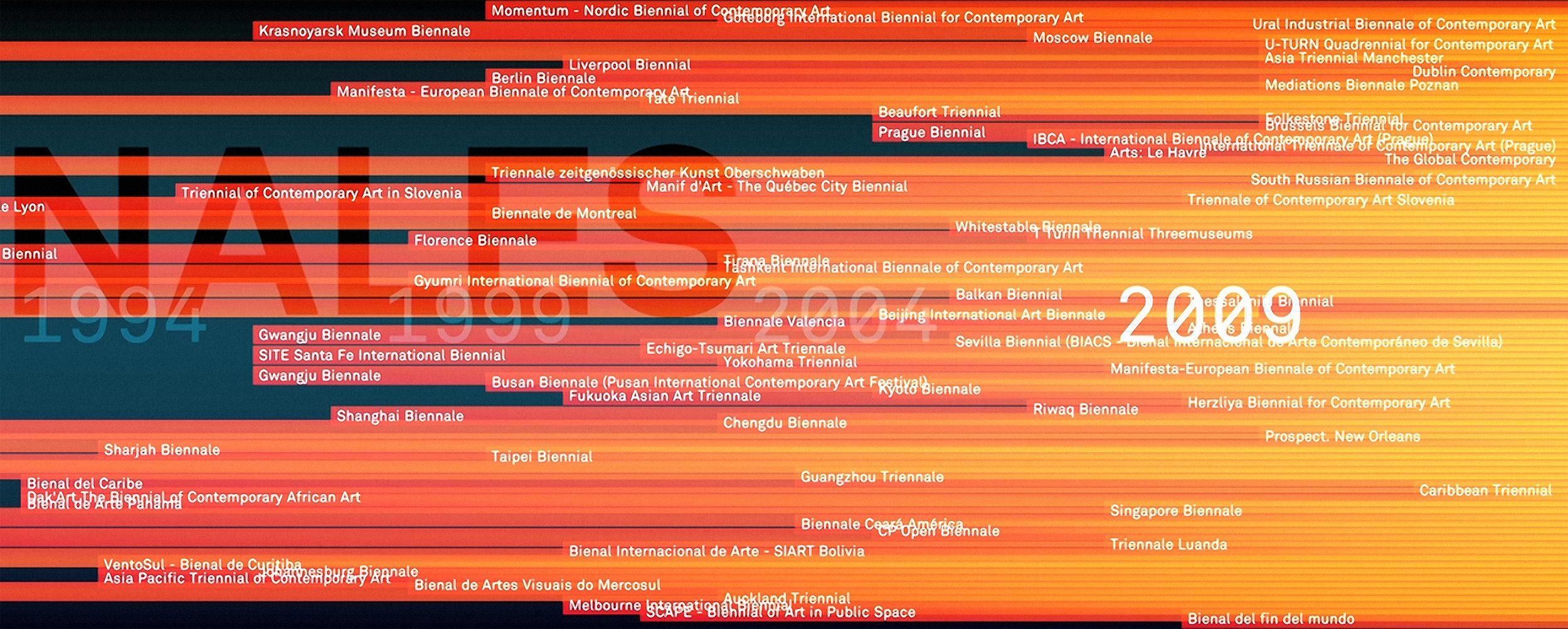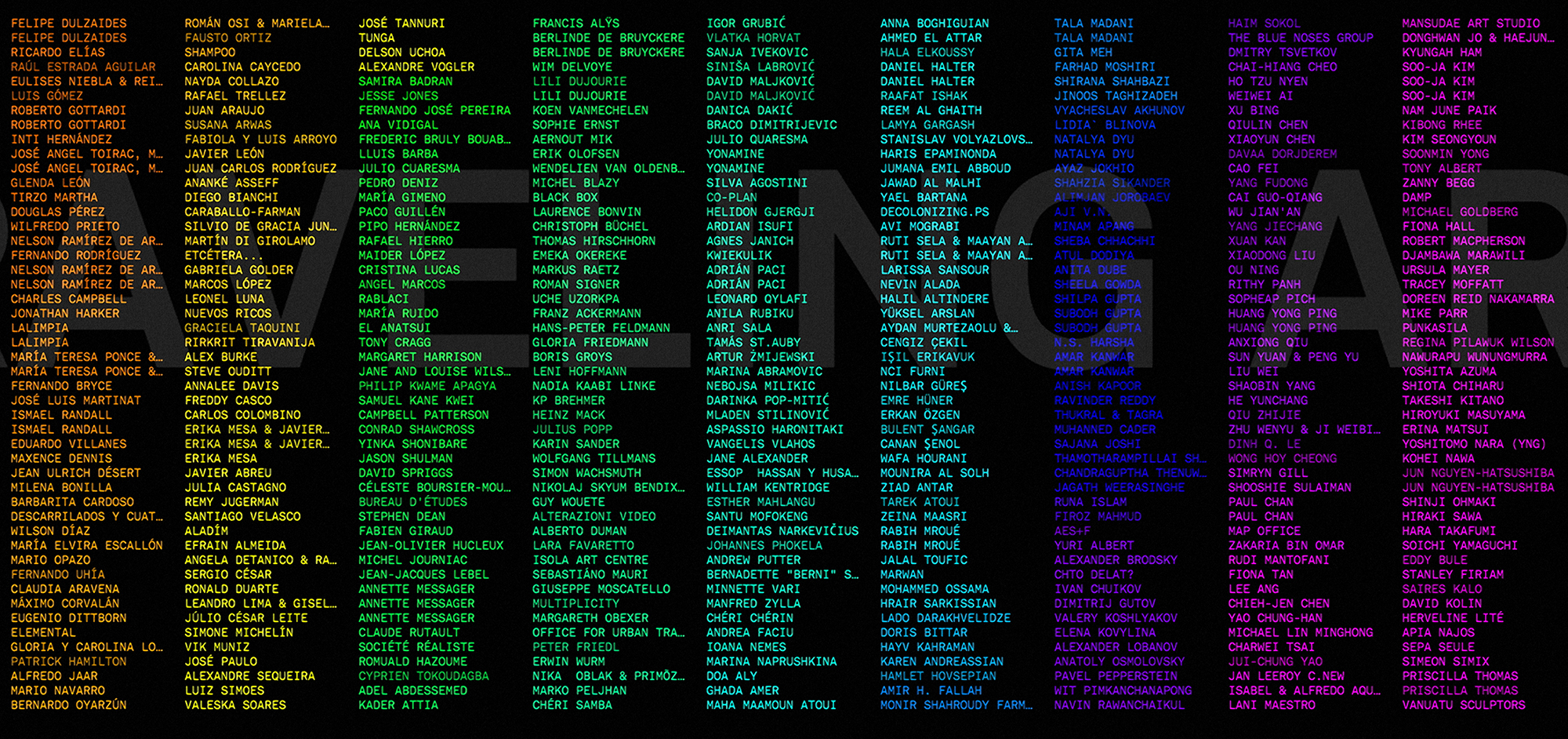PROJECTS / TRANS_ACTIONS (2011)
8K Panoramic video projection, running time: 25 minutes
trans_actions was designed in response to the writings and research of German art historian, Hans Belting, who curated the exhibition, “The Global Contemporary: Art Worlds After 1989,” at the ZKM Center for Art and Media. The exhibition indexed the increasing entanglement of contemporary art with market forces and economic speculation. trans_actions was commissioned specifically for this exhibition to depicted these complex relationships through a dynamic and immersive use of data.
trans_actions takes the form of three data narratives: Biennalization, Traveling Artists, and the Global Art Market. Each scene shows the geographic distribution of art practices that have emerged alongside speculative uses of the art market.
This piece is similar to Warning Office’s work in its ambition to use data as a new rhetorical mode for communicating to the public about contemporary spatial processes. However, it is significantly different in its research methodology. With trans_actions, we worked exclusively with media that are not conventionally considered to be geospatial datasets, and translated these media into digital formats through which latent geographic patterns could be highlighted. Furthermore, this media was not simply mapped; it was used to create a “Domain Ontology,” or “Ontological Database,” that captured the social, spatial, and economic relationships among numerous entities in the art world. In other words, we first constructed a model of the art world, and then made visualizations of this model. For example, we enlisted several research assistants to analyze a comprehensive collection of Biennale exhibition catalogs— a corpus not normally considered a geospatial dataset. They extract every artwork, artist, curator, and relevant social connection. In the Ontological Database, these individuals and their relations over time is what is represented.
scene 01 Biennalization
The Biennalization scene created a comprehensive timeline of all Biennales and Art Fairs throughout the 20th Century. Each fair is depicted as a linear connection between its start year and end year. (Vertically, they are organized by their geographic latitude.) The scene demonstrates that since 1989 there has be a remarkable increase in the number and geographic dispersion of Biennales and Art Fairs. The scene paints the room with these fairs through the present, at which point, they are all resorted vertically by their start date thus demonstrating the exponential growth in the contemporary era. The data for this scene was hand-translated from a vast repository of art fair catalogs.
scene 02 Traveling Artists
trans_actions’ ontological database contains a vast set of art fairs, contemporary artists, curators, art auctions, and economic data. The Traveling Artist scene tracked the movements of several hundred artists and curators through the network of global art fairs. This scene highlighted a new unknown geography of the art fairs. The dominant claims about Biennales celebrate their function of introducing local artists to a global audience. Through our visualizations, another, unacknowledged spatial dynamic was highlighted. The fairs provide a circuit through which international curators circulate a select cohort of European, American, and increasingly, Chinese artists. This increases their visibility and ultimately their market value. Visualized as both a flow map, and as a dense and growing registry of artists, the repeated appearance or a small set of artists is readily apparent.
scene 03 Global Art Market
The Global Art Market scene explores the contemporary trend of purchasing of art as a financial investment and frames it as a form of geographic speculation. A large collection of contemporary art auction catalogs from Sotheby’s and Christie’s were entered into the trans_action database. Any catalog that mentioned a geographic region in its title was used to map over time when different geographic regions appeared in the global art work, and when purchasing contemporary art from those regions was determined by financial rather than aesthetic criteria. These findings were combined with macro economic indicators about the countries with the fastest growing number of millionaires and billionaires. These countries were mapped through the number of galleries and auction houses that have appeared in these countries as well as the monetary value of the art transactions occurring there.
VISUAL DESIGN
Robert Gerard Pietrusko
Stewart Smith
NARRATIVE
Robert Gerard Pietrusko
Stewart Smith
Bernd Lintermann
SOUND DESIGN
Ludger Brümmer
[PROJECTS]
EXHIBITIONS
14.10 - 16.10.2016
Deterritorialized Complexity
ZKM Center for Art and Media
Karlsruhe, Germany
01.02.2013 - 24.03.2013
Nothing to Declare? World Maps of Art since ‘89
Akademie der Künste
Berlin, Germany
17.09.2011 – 05.02.2012
The Global Contemporary: Art Worlds After ’89
ZKM Center for Art and Media
Karlsruhe, Germany
PUBLICATIONS FEATURING TRANS_ACTIONS
Terry Smith. Thinking Contemporary Curating (Independent Curators International, 2015)
Hans Belting, Andrea Buddensieg, Peter Weibel (eds). The Global Contemporary and the Rise of the New Art Worlds (MIT Press, 2013)
Kerstin Winking. The Global Contemporary. Third Text 26 no. 5 (2012).












